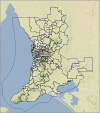Geospatial analysis of Helicobacter pylori infection in South Australia: Should location influence eradication therapy?
- PMID: 35315547
- PMCID: PMC9543722
- DOI: 10.1111/jgh.15832
Geospatial analysis of Helicobacter pylori infection in South Australia: Should location influence eradication therapy?
Abstract
Background and aim: Rates of antimicrobial-resistant Helicobacter pylori infection are rising globally; however, geospatial location and its interaction with risk factors for infection have not been closely examined.
Methods: Gastric biopsy specimens were collected to detect H. pylori infection at multiple centers in Adelaide, South Australia, between 1998 and 2017. The geospatial distribution of antibiotic-resistant H. pylori in the Greater Adelaide region was plotted using choropleth maps. Moran's I was used to assess geospatial correlation, and multivariate linear regression (MLR) was used to examine associations between migration status, socioeconomic status, age, gender, and rates of H. pylori positivity and antibiotic resistance. Geographically weighted regression (GWR) was used to determine the extent to which the associations varied according to geospatial location.
Results: Of 20 108 biopsies across 136 postcodes within the Greater Adelaide region, 1901 (9.45%) were H. pylori positive. Of these, 797 (41.9%) displayed clarithromycin, tetracycline, metronidazole, or amoxicillin resistance. In MLR, migration status was associated with the rate of H. pylori positivity (β = 3.85% per 10% increase in a postcode's migrant population; P < 0.001). H. pylori positivity and resistance to any antibiotic were geospatially clustered (Moran's I = 0.571 and 0.280, respectively; P < 0.001 for both). In GWR, there was significant geospatial variation in the strength of the migrant association for both H. pylori positivity and antibiotic resistance.
Conclusion: Our study demonstrates the heterogeneous geospatial distribution of H. pylori positivity and antibiotic resistance, as well as its interaction with migrant status. Geographic location and migrant status are important factors to consider for H. pylori eradication therapy.
Keywords: Helicobacter pylori; antibiotics; antimicrobial; antimicrobial resistance; geospatial; resistance.
© 2022 The Authors. Journal of Gastroenterology and Hepatology published by Journal of Gastroenterology and Hepatology Foundation and John Wiley & Sons Australia, Ltd.
Figures









Similar articles
-
Increasing Helicobacter pylori clarithromycin resistance in Australia over 20 years.Intern Med J. 2022 Sep;52(9):1554-1560. doi: 10.1111/imj.15640. Epub 2022 Aug 19. Intern Med J. 2022. PMID: 34865299
-
The effect of previous eradication failure on antibiotic resistance of Helicobacter pylori: A retrospective study over 8 years in Beijing.Helicobacter. 2021 Aug;26(4):e12804. doi: 10.1111/hel.12804. Epub 2021 Apr 16. Helicobacter. 2021. PMID: 33860967
-
High incidence of antibiotic resistance amongst isolates of Helicobacter pylori collected in Nottingham, UK, between 2001 and 2018.J Med Microbiol. 2023 Nov;72(11). doi: 10.1099/jmm.0.001776. J Med Microbiol. 2023. PMID: 37962209
-
Antibiotic resistance of Helicobacter pylori in Australia and New Zealand: A systematic review and meta-analysis.J Gastroenterol Hepatol. 2021 Jun;36(6):1450-1456. doi: 10.1111/jgh.15352. Epub 2021 Jan 3. J Gastroenterol Hepatol. 2021. PMID: 33217029
-
Novel and Effective Therapeutic Regimens for Helicobacter pylori in an Era of Increasing Antibiotic Resistance.Front Cell Infect Microbiol. 2017 May 5;7:168. doi: 10.3389/fcimb.2017.00168. eCollection 2017. Front Cell Infect Microbiol. 2017. PMID: 28529929 Free PMC article. Review.
Cited by
-
Mutations Associated to Antibiotic-Resistant Helicobacter pylori: It Is Time to Validate Sequencing Observations.J Clin Med. 2022 Jul 24;11(15):4293. doi: 10.3390/jcm11154293. J Clin Med. 2022. PMID: 35893384 Free PMC article.
-
Epidemiology of Helicobacter pylori Resistance to Antibiotics (A Narrative Review).Antibiotics (Basel). 2023 Jul 13;12(7):1184. doi: 10.3390/antibiotics12071184. Antibiotics (Basel). 2023. PMID: 37508280 Free PMC article. Review.
-
Sustain-release lipid-liquid crystal formulations of pexiganan against Helicobacter pylori infection: in vitro evaluation in C57BL/6 mice.BMC Pharmacol Toxicol. 2024 Jan 11;25(1):9. doi: 10.1186/s40360-024-00731-z. BMC Pharmacol Toxicol. 2024. PMID: 38212864 Free PMC article.
References
-
- Cromley EK. GIS and disease. Annu. Rev. Public Health 2003; 24: 7–24. - PubMed
-
- González CA, Megraud F, Buissonniere A et al. Helicobacter pylori infection assessed by ELISA and by immunoblot and noncardia gastric cancer risk in a prospective study: the Eurgast‐EPIC project. Ann. Oncol. 2012; 23: 1320–1324. - PubMed
-
- Lee YC, Chiang TH, Chou CK et al. Association between Helicobacter pylori eradication and gastric cancer incidence: a systematic review and meta‐analysis. Gastroenterology 2016; 150: 1113–24.e5. - PubMed
-
- Ford AC, Yuan Y, Moayyedi P. Helicobacter pylori eradication therapy to prevent gastric cancer: systematic review and meta‐analysis. Gut 2020; 69: 2113–2121. - PubMed
MeSH terms
Substances
LinkOut - more resources
Full Text Sources
Medical

